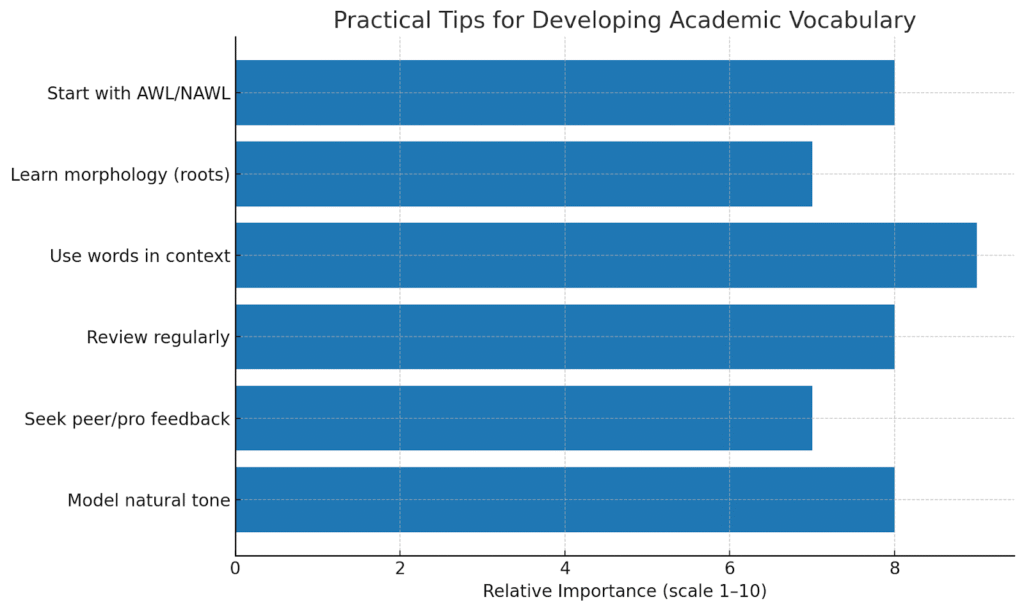How to Develop an Academic Vocabulary Without Sounding Pretentious
In academic contexts, possessing a strong academic vocabulary is invaluable—but the challenge lies in using it without coming across as pretentious. The goal is not to sound inflated but to communicate ideas with clarity, authority, and authenticity. Crafting discourse that reflects depth and precision, while remaining accessible, is an art that requires deliberate practice.
This post explores strategies grounded in research and pedagogical best practices. Readers will gain insight into how to improve vocabulary, strengthen academic language skills, and engage in effective vocabulary building—all while preserving a natural tone. Along the way, I’ll also highlight how professional vocabulary development can be supported through services like thesis-edit.com.
The Challenge: Balancing Academic Vocabulary and Natural Tone
Academic vocabulary often includes terms from Latin or Greek roots, discipline-specific phrases, and high-register words common in scholarly writing. While these terms can add precision, their overuse may alienate readers or obscure meaning. Especially for English learners or novice writers, the fine line between writing with clarity and precision and sounding overly grandiloquent can be difficult to navigate.
Scholars have long distinguished between Basic Interpersonal Communication Skills (BICS)—the fluency needed for everyday conversation—and Cognitive Academic Language Proficiency (CALP), the ability to use and understand formal academic language. Many learners achieve conversational fluency but still struggle academically due to gaps in CALP. Bridging this gap requires intentional strategies.
Evidence-Based Vocabulary Strategies That Enhance Clarity
A growing body of research suggests that vocabulary instruction must extend beyond memorization to focus on meaning, morphology, and context (pmc.ncbi.nlm.nih.gov, readingrockets.org).
Present Meaning, Morphology, and Context
- Morphological awareness: Learning Latin or Greek roots (such as voc, meaning “speak”) helps writers decode unfamiliar words without resorting to inappropriate synonyms (texasldcenter.org, nwea.org).
- Rich definitions: Exploring synonyms, antonyms, real-life examples, and analogies deepens understanding (readingrockets.org).
- Contextual usage: Encountering words across reading, writing, listening, and discussion ensures natural use, avoiding forced application (hmhco.com).
Review and Active Engagement
Retention improves when vocabulary is revisited and applied across varied contexts. Effective techniques include:
- Word review routines (peer review, sentence creation, or “which word fits?” exercises).
- Graphic organizers such as the Frayer Model, which integrates definition, examples, and non-examples.
- Promoting “word consciousness,” where learners notice and explore vocabulary independently.
Teaching Tier-2 Words
Beck, McKeown, and Kucan’s Three-Tier Model is a helpful framework:
- Tier 1: Basic, everyday words.
- Tier 2: Academic/general utility words (e.g., analyze, interpret).
- Tier 3: Low-frequency, discipline-specific terms.
Prioritizing Tier 2 words enhances comprehension across subjects while avoiding overwhelming learners with overly technical terms. This balance strengthens both academic vocabulary strategies and effective vocabulary building.
Applying These Strategies Naturally: Avoiding the Pretentious Trap
Learning academic words is only half the task; applying them naturally is equally important. Here are four approaches:
- Start with clarity: Introduce ideas in simple language before substituting with precise academic terms.
- Explain or scaffold: Provide context or definitions when using less familiar terms.
- Use strategically: Reserve high-register vocabulary for moments when it adds precision. Avoid long strings of obscure words.
- Test through feedback: Share writing with peers or professionals. Services like thesis-edit.com provide expert feedback that ensures vocabulary use strengthens clarity rather than weakens it.
Supporting Research and Current Debates
Recent debates highlight both theoretical and practical considerations in vocabulary instruction.
- Instructional foundations: A systematic review shows vocabulary instruction often draws on schema theory, psycholinguistic theory, social constructivism, and dual coding theory, with visuals and multimedia proving effective.
- Learner perceptions: Research with first-year ESL undergraduates in Hong Kong revealed that although students value academic vocabulary, they often find words too complex and rarely encountered outside texts. This points to the need for engaging, habit-forming practices.
- Resources like AWL/NAWL: The Academic Word List (AWL), and its update, the NAWL, provide curated word lists that support learners entering higher education.
- Technology and equity: Emerging studies suggest that AI tools, such as ChatGPT, can help non-native English-speaking researchers integrate academic vocabulary naturally, enhancing lexical complexity without pretentiousness.
Practical Steps
To translate theory into practice, consider these six steps:
- Start with AWL/NAWL: Build a foundation with common academic terms.
- Engage deeply: Study roots, prefixes, and suffixes; build semantic networks.
- Use vocabulary in context: Incorporate new words in speaking and writing.
- Review regularly: Revisit and recycle vocabulary through various tasks.
- Get feedback: Use peer review or services like thesis-edit.com for refinement.
- Model natural tone: Read quality scholarship and emulate its balance of clarity and formality.
Table: Practical Tips for Developing Academic Vocabulary
| Strategy | Explanation |
| Start with AWL/NAWL | Build a foundation using common academic word lists to strengthen core vocabulary. |
| Learn morphology | Study prefixes, suffixes, and roots to decode and understand new words. |
| Use words in context | Apply vocabulary in writing, discussions, and examples instead of memorizing in isolation. |
| Review regularly | Reinforce learning through repetition, quizzes, and self-testing. |
| Seek peer/pro feedback | Use peer review or professional editing (e.g., thesis-edit.com) to refine natural usage. |
| Model natural tone | Read scholarly writing that balances clarity and formality. |
Chart: Practical Tips for Academic Vocabulary Development

Conclusion
Developing an academic vocabulary without sounding pretentious is entirely achievable—and deeply rewarding. By grounding learning in morphology, context, and deliberate practice, writers can enhance precision without sacrificing readability. Resources like AWL/NAWL, AI tools, and professional feedback from services such as thesis-edit.com further support this process.
Ultimately, vocabulary should be a tool, not an ornament. Used thoughtfully, it elevates scholarly work by serving clarity, not ego.

